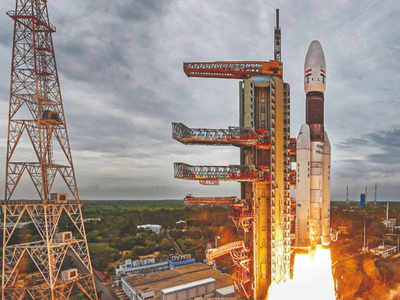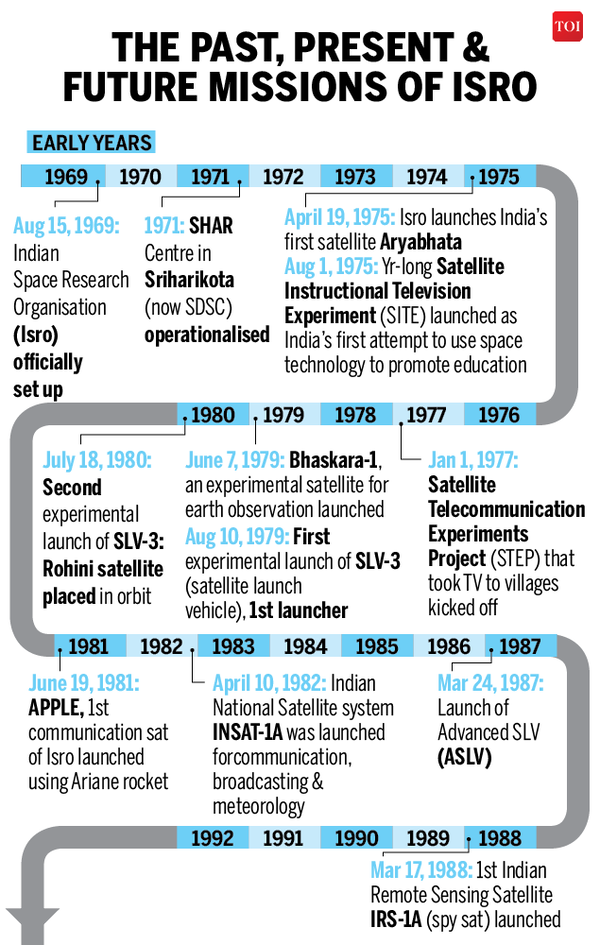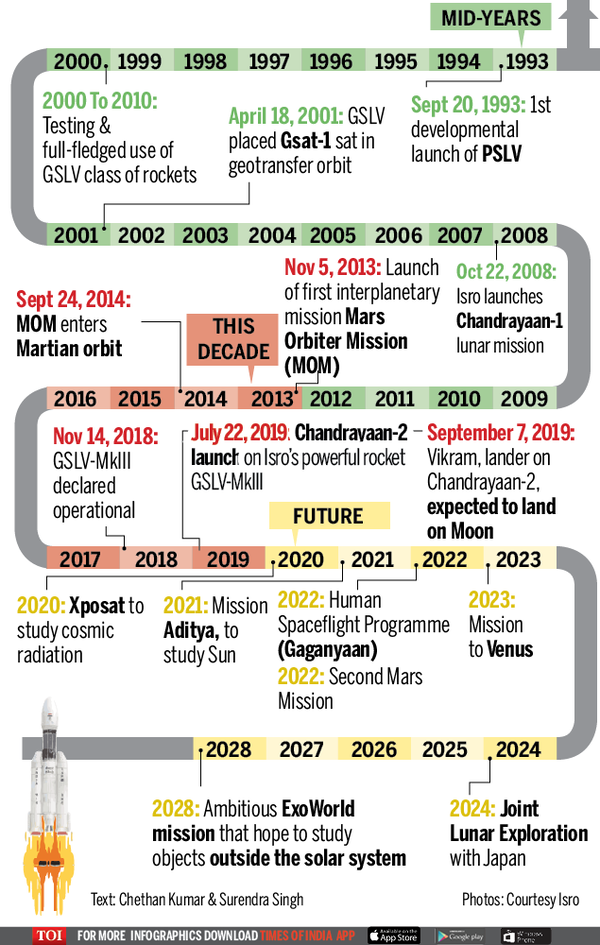- News
- India News
- Isro sowing seeds of future technology to help next generation go beyond Earth
Trending
This story is from August 16, 2019
Isro sowing seeds of future technology to help next generation go beyond Earth
On the golden jubilee year of Isro, chairman K Sivan told TOI, “In the last 50 years, Isro’s key mission was to develop space technologies that would benefit the common man." He said,“We are now looking to..develop technologies required for future...Mars Orbiter Mission and Chandrayaan-1 and -2 missions are in that direction...sowing the seeds of future tech."

GSLV MkIII rocket carrying Chandrayaan-2 module being launched from Sriharikota on July 22 this year.
Key Highlights
- When Isro was set up on August 15, 1969, the country didn’t have space infrastructure nor expertise to launch big rockets
- On the golden jubilee year of Isro, the space agency chief Sivan said, “We are now looking to achieve the second mission: To develop technologies required for future"
NEW DELHI: In the last 50 years since it was founded, Indian Space Research Organisation (Isro) has come a long way by overcoming technological hurdles and achieving several milestones. From launching sounding rockets carrying a payload of just 30-70kg to 150km altitude from a church-turned-launchpad at Thumba in Kerala’s Trivandrum (now Thiruvananthapuram) in early 1960s, Isro is now launching 4,000-kg payload to the geostationary orbit at 36,000-km altitude.The agency’s giant leap in space technology has been phenomenal whether it is the development of cryogenic engine for powering its heavy-payload launcher or making India’s heaviest satellite Gsat-11 weighing over five tonnes.

When Isro was set up on August 15, 1969, the country didn’t have space infrastructure nor expertise to launch big rockets. But now the agency has an array of rockets in its arsenal. Its PSLV can not only lift over a hundred satellites in one attempt, but can also put satellites in different orbits in a single mission. Likewise, its GSLV rocket is capable of launching bulky satellites to the geo orbit and is also being used to launch interplanetary missions like Chandrayaan-2.


Sivan said, “We are now looking to achieve the second mission: To develop technologies required for future. The launch of interplanetary missions like Mars Orbiter Mission and Chandrayaan-1 and -2 missions are in that direction. We are sowing the seeds of future technologies so that our next generation will reap their benefits 50 years from now. This is because resources on Earth like water and energy are fast depleting. We may have to depend on other celestial bodies in future to fufil our basic needs. To find a way to reach these planets, we are therefore launching interplanetary missions.”
Sivan said after the Chandrayaan-2 mission, the human spaceflight programme or Gagayaan will be Isro’s top priority. "We have to launch the mission by 2022, the deadline fixed by PM Narendra Modi. After the completion of Gaganyaan by 2022, Isro will work on setting up India’s own space station,” he said.


Isro has also lined up a series of interplanetary missions like Aditya (sun), Venus and space science programmes. "To carry heavier payload (over 4 tonnes) for interplanetary missions, Isro is also working on increasing the lifting capability of GSLV-MkIII and developing a new heavylift launch vehicle," Sivan told TOI. He said a series of highthroughput satellites will also be launched to provide digital connectivity to remote parts of the country.
The agency is also working on a mini-PSLV or Small Satellite Launch Vehicle whose maiden demonstration test-flight is due in December this year. This SSLV rocket, which can assembled in just 3-4 days as compared to 30-40 days for a normal-size rocket like PSLV, will be a money spinner for the space agency as this is a vehicle on demand. "Whenever there will be an urgent demand to launch a satellite weighing up to 500kg, we can assemble an SSLV on a short notice," Sivan said.
Another key project of Isro is the Reusable Launch Vehicle (RLV). Sivan said "a demonstration test of RLV is due after the Chandrayaan-2 landing in September. This will be a landing experiment". In the landing experiment, an RLV will be launched into the sky with the help of a small rocket. The RLV after being lifted up for a few kilometres will glide back to Earth and land on an airstrip. If Isro is able to set up its own space station in space after some years, the RLV will play a key role in transporting humans to and from the space station.
All these big-ticket missions will definitely require a lot of Budget. Sivan says, "Money has never been an issue as we had never faced a financial scarcity. Whenever we asked money from the government for a big project, we have received it." The Indian space agency is now famous in the world for launching big space programmes like Mars or Chandrayaan missions on a small budget. In fact, the budget of a Hollywood movie is bigger than the total cost of India's interplanetary mission like Mars Orbiter Mission. Chandrayaan-2 has cost Isro Rs 978 crore ($140 million approximately), which is less than half the budget of the 'Avengers Endgame' movie, whose budget was $356 million. It is also less than the budget of another Hollywood movie 'Interstellar', a sci-fi movie made in 2014 with $165 million.
With a series of interplanetary missions, Gaganyaan and space station projects lined up, the coming five years will really be busy period for the Indian space agency. The big-ticket space programmes also show that Isro has come a long way in the last 50 years and is going strong technologically with each passing year. Time is not far when Isro will be capable of launching space tourism or taking Indians to Moon on holiday.

An APPLE satellite being carried on a bullock cart in early 1960s.
When Isro was set up on August 15, 1969, the country didn’t have space infrastructure nor expertise to launch big rockets. But now the agency has an array of rockets in its arsenal. Its PSLV can not only lift over a hundred satellites in one attempt, but can also put satellites in different orbits in a single mission. Likewise, its GSLV rocket is capable of launching bulky satellites to the geo orbit and is also being used to launch interplanetary missions like Chandrayaan-2.

India’s first own satellite Aryabhata launched on April 19, 1975 by a Russian rocket.
On the golden jubilee year of Isro, its chairman K Sivan told TOI, “In the last 50 years, Isro’s key mission was to develop space technologies that would benefit the common man. We have therefore established a big space infrastructure, space transport system and various space applications to meet the requirement of the people of India and fulfill the vision of the father of Indian space programme Vikram Sarabhai, who always pushed for using space technology for the welfare of society.”

Sivan said, “We are now looking to achieve the second mission: To develop technologies required for future. The launch of interplanetary missions like Mars Orbiter Mission and Chandrayaan-1 and -2 missions are in that direction. We are sowing the seeds of future technologies so that our next generation will reap their benefits 50 years from now. This is because resources on Earth like water and energy are fast depleting. We may have to depend on other celestial bodies in future to fufil our basic needs. To find a way to reach these planets, we are therefore launching interplanetary missions.”
Sivan said after the Chandrayaan-2 mission, the human spaceflight programme or Gagayaan will be Isro’s top priority. "We have to launch the mission by 2022, the deadline fixed by PM Narendra Modi. After the completion of Gaganyaan by 2022, Isro will work on setting up India’s own space station,” he said.


Isro has also lined up a series of interplanetary missions like Aditya (sun), Venus and space science programmes. "To carry heavier payload (over 4 tonnes) for interplanetary missions, Isro is also working on increasing the lifting capability of GSLV-MkIII and developing a new heavylift launch vehicle," Sivan told TOI. He said a series of highthroughput satellites will also be launched to provide digital connectivity to remote parts of the country.
The agency is also working on a mini-PSLV or Small Satellite Launch Vehicle whose maiden demonstration test-flight is due in December this year. This SSLV rocket, which can assembled in just 3-4 days as compared to 30-40 days for a normal-size rocket like PSLV, will be a money spinner for the space agency as this is a vehicle on demand. "Whenever there will be an urgent demand to launch a satellite weighing up to 500kg, we can assemble an SSLV on a short notice," Sivan said.
Another key project of Isro is the Reusable Launch Vehicle (RLV). Sivan said "a demonstration test of RLV is due after the Chandrayaan-2 landing in September. This will be a landing experiment". In the landing experiment, an RLV will be launched into the sky with the help of a small rocket. The RLV after being lifted up for a few kilometres will glide back to Earth and land on an airstrip. If Isro is able to set up its own space station in space after some years, the RLV will play a key role in transporting humans to and from the space station.
All these big-ticket missions will definitely require a lot of Budget. Sivan says, "Money has never been an issue as we had never faced a financial scarcity. Whenever we asked money from the government for a big project, we have received it." The Indian space agency is now famous in the world for launching big space programmes like Mars or Chandrayaan missions on a small budget. In fact, the budget of a Hollywood movie is bigger than the total cost of India's interplanetary mission like Mars Orbiter Mission. Chandrayaan-2 has cost Isro Rs 978 crore ($140 million approximately), which is less than half the budget of the 'Avengers Endgame' movie, whose budget was $356 million. It is also less than the budget of another Hollywood movie 'Interstellar', a sci-fi movie made in 2014 with $165 million.
With a series of interplanetary missions, Gaganyaan and space station projects lined up, the coming five years will really be busy period for the Indian space agency. The big-ticket space programmes also show that Isro has come a long way in the last 50 years and is going strong technologically with each passing year. Time is not far when Isro will be capable of launching space tourism or taking Indians to Moon on holiday.
End of Article
FOLLOW US ON SOCIAL MEDIA










